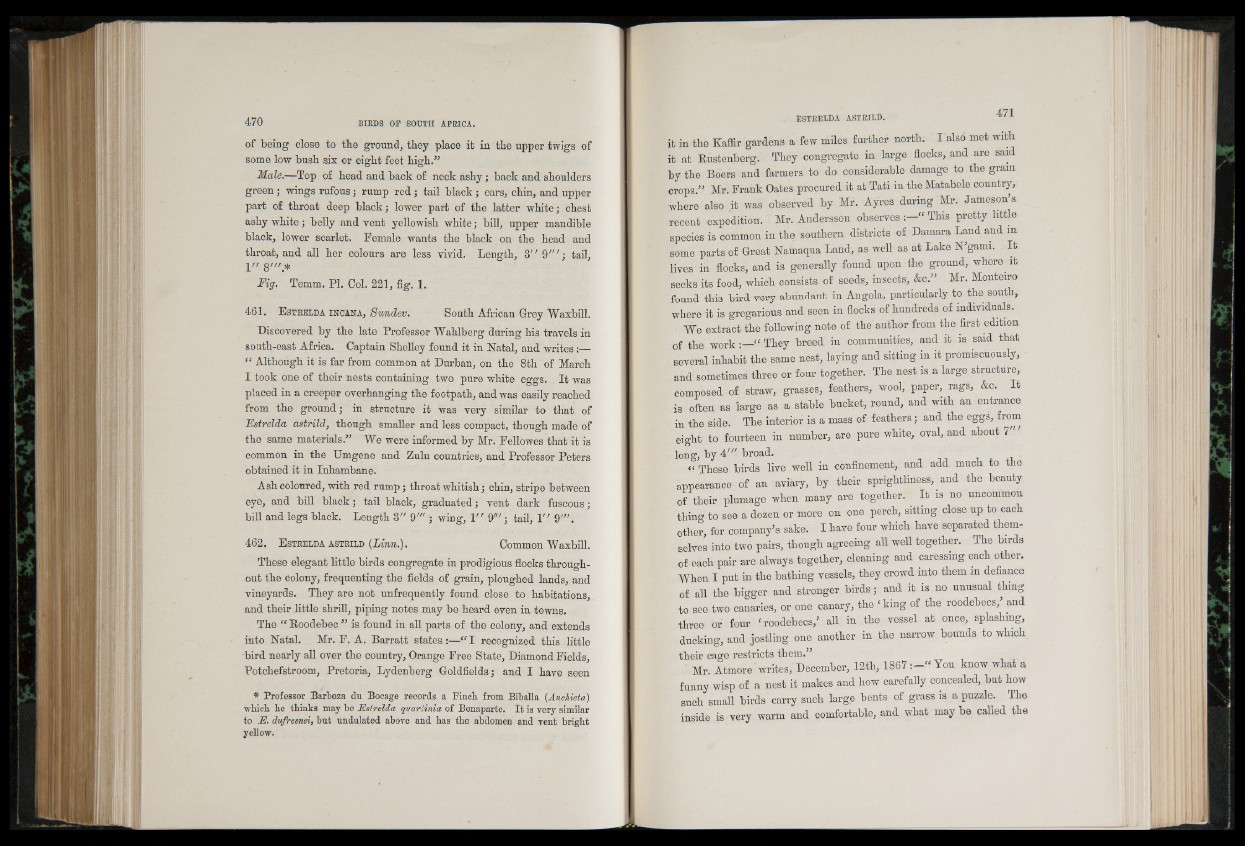
of being close to tbe ground, they place it in the upper twigs of
some low bush six or eight feet high.”
Male.—Top of head and back of neck ashy; back and shoulders
green; wings rufous; rump red ; tail black ; ears, chin, and upper
part of throat deep black; lower part of the latter white; chest
ashy white; belly and vent yellowish white; bill, upper mandible
black, lower scarlet. Female wants the black on the head and
throat, and all her colours are less vivid. Length, 3" 9 " ') tail,
1" 8"'.*
Fig. Temm. PI. Col. 221, fig. 1.
461. E strelda incana, Sundev. South African Grey Waxbill.
Discovered by the late Professor Wahlberg during his travels in
south-east Africa. Captain Shelley found it in Natal, and writes:—
“ Although it is far from common at Durban, on the 8 th of March
I took one of their nests containing two pure white eggs. It was
placed in a creeper overhanging the footpath, and was easily reached
from the ground; in structure it was very similar to that of
Fstrelda astrild, though smaller and less compact, though made of
the same materials.” We were informed by Mr. Fellowes that it is
common in the Umgene and Zulu countries, and Professor Peters
obtained it in Inhambane.
Ash coloured, with red rump; throat whitish; chin, stripe between
eye, and bill black; tail black, graduated; vent dark fuscous;
bill and legs black. Length 3” 9 " '; wing, 1" 9"' ) tail, 1" 9'".
462. E strelda astrild (Linn.). Common Waxbill.
These elegant little birds congregate in prodigious flocks throughout
the colony, frequenting the fields of grain, ploughed lands, and
vineyards. They are not unfrequently found close to habitations,
and their little shrill, piping notes may be heard even in towns.
The “ Roodebec” is found in all parts of the colony, and extends
into Natal. Mr. F. A. Barratt states :—“ I recognized this little
bird nearly all over the country, Orange Free State, Diamond Fields,
Potchefstroom, Pretoria, Lydenberg Goldfields; and I have seen
* Professor Barboza du Bocage records a Finch from Biballa (Anchieta)
which he thinks may be Estrelda quariinia of Bonaparte. I t is very similar
to E . dufresnei, but undulated above and has the abdomen and vent bright
yellow.
it in the Nnffir gardens a few miles further north. I also met with
it at Rustenberg. They congregate in large flocks, and are said
by the Boers and farmers to do considerable damage to the gram
crops.” Mr. Frank Oates procured it at Tati in the Matabele country,
where also it was observed by Mr. Ayres during Mr. Jameson’s
recent expedition. Mr. Andersson observes “ This pretty little
species is common in the. southern districts of Damara Land and m
some parts of Great Namaqua Land, as well as at Lake N’gami. I t
lives in flocks, and is generally found upon the ground, where it
seeks its food, which consists of seeds, insects, &c.” Mr. Monteiro
found this bird very abundant in Angola, particularly to the south,
Where it is gregarious and seen in flocks of hundreds of individuals.
We extract the following note of the author from the first edition
of the work “ They breed in communities, and it is said that
several inhabit the same nest, laying and sitting in it promiscuously,
and sometimes three or four together. The nest is a large structure,
composed of straw, grasses, feathers, wool, paper, rags, &.c. It
is often as large as a stable bucket, round, and with an entrance
in the side. The interior is a mass of feathers; and the egg8, from
eight to fourteen in number, are pure white, oval, and about 7 '"
long, by 4"' broad.
“ These birds live well in confinement, and add much to the
appearance of an aviary, by their sprightliness, and the beauty
of their plumage when many are together. It is no uncommon
thing to see a dozen or more on one perch, sitting close up to each
other, for company’s sake. I have four which have separated themselves
into two pairs, though agreeing all well together. The birds
of each pair are always together, cleaning and caressing each other.
When I put in the bathing vessels, they crowd into them in defiance
of all the bigger and stronger birds ; and it is no unusual thing
to see two canaries, or one canary, the f king of the roodebecs,’ and
three or four f roodebecs,’ all in the vessel at once, splashing,
ducking, and jostling one another in the narrow bounds to which
their cage restricts them.
Mr. Atmore writes, December, 12th, 1867 You know what a
funny wisp of a nest it makes and how carefully concealed, but how
such small birds carry such large bents of grass is a puzzle. The
inside is very warm and comfortable, and what may be called the